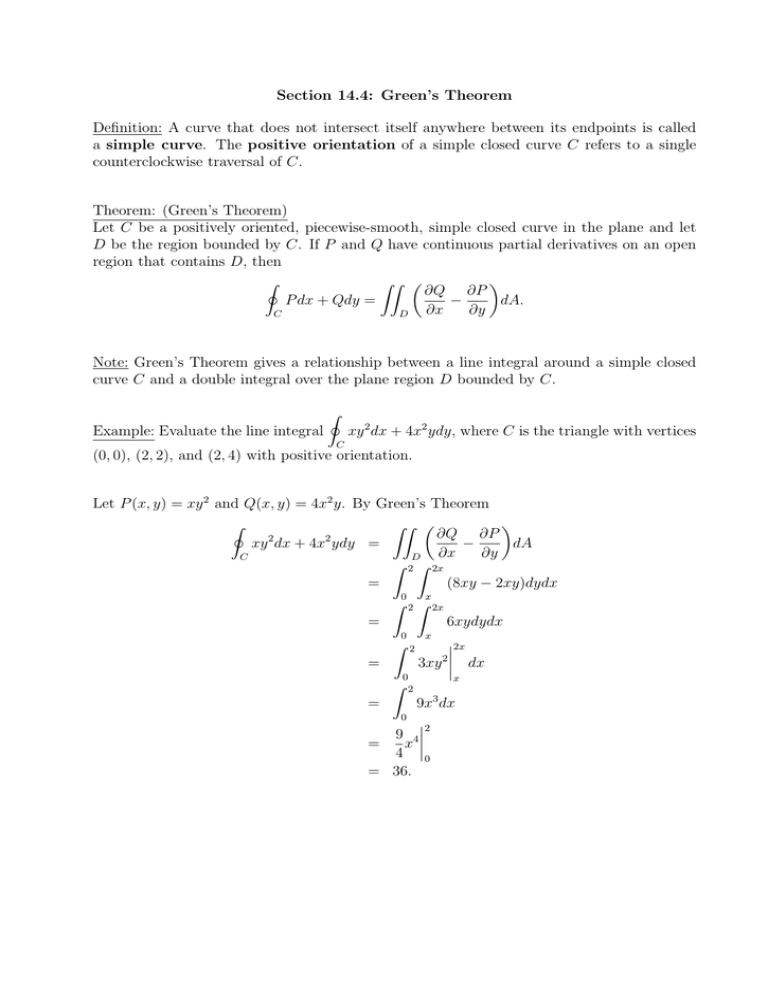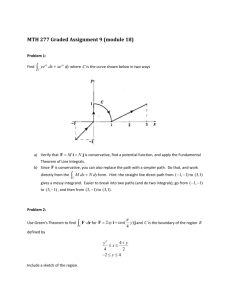Section 14.4: Green’s Theorem
advertisement

Section 14.4: Green’s Theorem Definition: A curve that does not intersect itself anywhere between its endpoints is called a simple curve. The positive orientation of a simple closed curve C refers to a single counterclockwise traversal of C. Theorem: (Green’s Theorem) Let C be a positively oriented, piecewise-smooth, simple closed curve in the plane and let D be the region bounded by C. If P and Q have continuous partial derivatives on an open region that contains D, then I ZZ ∂Q ∂P − dA. P dx + Qdy = ∂x ∂y C D Note: Green’s Theorem gives a relationship between a line integral around a simple closed curve C and a double integral over the plane region D bounded by C. I Example: Evaluate the line integral xy 2 dx + 4x2 ydy, where C is the triangle with vertices C (0, 0), (2, 2), and (2, 4) with positive orientation. Let P (x, y) = xy 2 and Q(x, y) = 4x2 y. By Green’s Theorem ZZ I ∂Q ∂P 2 2 xy dx + 4x ydy = − dA ∂x ∂y D C Z 2 Z 2x = (8xy − 2xy)dydx 0 x Z 2 Z 2x = 6xydydx 0 x 2x Z 2 2 3xy dx = 0 x Z 2 = 9x3 dx 0 2 9 4 = x 4 0 = 36. I −2y 3 dx + 2x3 dy, where C is the circle x2 + y 2 = 4. Example: Evaluate the line integral C Let P (x, y) = −2y 3 and Q(x, y) = 2x3 . By Green’s Theorem I ZZ ∂Q ∂P 3 3 − dA −2y dx + 2x dy = ∂x ∂y C D ZZ = 6x2 + 6y 2 dA Z 2π Z 2 = 6r3 drdθ 0 0 2 3 4 r = 2π 2 0 = 2π(24) = 48π. Example: Find the work done by the force F~ (x, y) = h7x, x3 + 3xy 2 i in moving a particle √ from the point (−2, 0) along the x-axis to (2, 0), and then along the semicircle y = 4 − x2 to the starting point. The work done is given by I W = ~ F~ · dR. C Let P (x, y) = 7x and Q(x, y) = x3 + 3xy 2 . By Green’s Theorem, ZZ (3x2 + 3y 2 )dA W = D Z 2π Z 2 = 3r3 drdθ 0 Z 20 = 2π 3r3 dr 0 2 3π 4 = r 2 0 = 24π. Note: Note that although the object is moved back to the starting point, the work done is non-zero since the force field is not conservative. Example: Find the work done by the force F~ (x, y) = hx2 + xy, xy 2 i in moving a particle from (0, 0) along the x-axis to (1, 0), then along the line segment to (0, 1), and then back to the origin along the y-axis. The work done is given by I W = ~ F~ · dR. C 2 2 Let P (x, y) = x + xy and Q(x, y) = xy . By Green’s Theorem, ZZ W = (y 2 − x)dA Z 1DZ 1−x (y 2 − x)dydx = 0 0 1−x Z 1 1 3 = dx y − xy 0 3 0 Z 1 1 = (1 − x)3 − x(1 − x)dx 3 Z0 1 = (1 − 4x + 4x2 − x3 )dx 0 1 4 3 1 4 2 = x − 2x + x − x 3 4 0 1 . = 12




